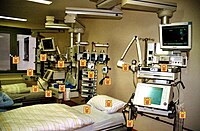
Photo from wikipedia
OBJECTIVES A significant proportion of healthcare workers (HCWs) had been infected with SARS-CoV-2, which complicated the organization of patient care during the COVID-19 pandemic. However, the exact scale of infection… Click to show full abstract
OBJECTIVES A significant proportion of healthcare workers (HCWs) had been infected with SARS-CoV-2, which complicated the organization of patient care during the COVID-19 pandemic. However, the exact scale of infection prevalence among the group of HCWs is not known, therefore this study aimed to assess the prevalence of SARS-CoV-2 infection among HCWs in the Silesian voivodeship, Poland, and to define its determinants. MATERIAL AND METHODS The cross-sectional study was conducted in 2 multidisciplinary hospitals in the Silesian voivodeship during the period October 2021-February 2022. The standardized WHO questionnaire Surveillance protocol for SARS-CoV-2 infection among health workers was completed by 242 HCWs. To assess the prevalence of SARS-CoV-2 infection and its determinants, such as personal, occupational, and work environment-related conditions and preventive behaviors, the collected data were subjected to statistical analysis. For this purpose, descriptive and analytical statistics (significance of differences in χ2 test) were used. RESULTS Almost half (42.6%) of subjects were infected with coronavirus, most frequently care assistants (57.1%) and paramedics (50%). People suffering from chronic diseases were infected significantly more often (p < 0.001). The majority of the infected HCWs declared previous contact with COVID-19 patients (56.3%). Unfortunately, 10.3% of respondents refused to be vaccinated against COVID-19, most often care assistants (38.1%) and nurses (10.6%). The determinants such as sex, age, occupation, place of work (ward), participation in occupational safety and health training, use of personal protective equipment (PPE), or preventive behaviors did not significantly affect the risk of infection (p > 0.05). CONCLUSIONS Even though the PPE was used and the percentage of fully vaccinated HCWs against COVID-19 was high (89.7%), the frequency of SARS-CoV-2 infected HCWs remains high at 42.6% (95% CI: 40.7-44.5%). The main determinants of SARS-CoV-2 infection risk among HCWs were previous contact with infected individuals and the presence of chronic disease.
Journal Title: International journal of occupational medicine and environmental health
Year Published: 2023
Link to full text (if available)
Share on Social Media: Sign Up to like & get
recommendations!